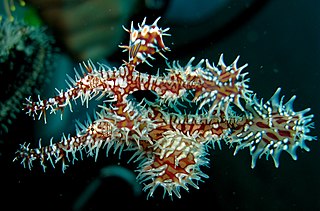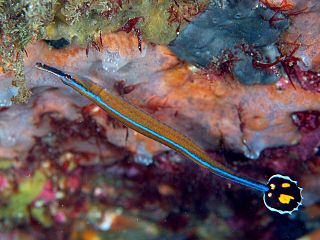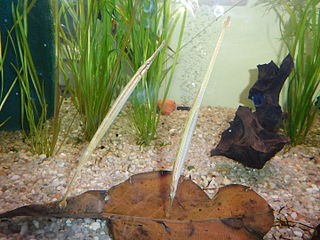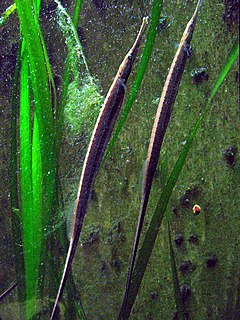
The Syngnathidae is a family of fish which includes seahorses, pipefishes, and seadragons. The name is derived from Greek, σύν (syn), meaning "together", and γνάθος (gnathos), meaning "jaw". This fused jaw trait is something the entire family has in common.

Pipefishes or pipe-fishes (Syngnathinae) are a subfamily of small fishes, which, together with the seahorses and seadragons, form the family Syngnathidae.

Solenostomus, also known as ghost pipefishes, false pipefishes or tubemouth fishes, is a genus of fishes in the order Syngnathiformes. Solenostomus is the only genus in the family Solenostomidae, and includes six currently recognized species. Ghostpipefishes are related to pipefishes and seahorses. They are found in tropical waters of the Indo-Pacific.
Solegnathus is a genus of pipefish native to the Indian and Pacific Oceans.

Acheilognathus is a genus of cyprinid fish native to Asia. The name is derived from the Greek a, meaning "without", the Greek cheilos, meaning "lip", and the Greek gnathos, meaning "jaw".

The greater pipefish is a pipefish of the family Syngnathidae. It is a seawater fish and the type species of the genus Syngnathus.

Doryrhamphus and Dunckerocampus, popularly known as flagtail pipefish, are two genera of fishes in the family Syngnathidae. They are found in warm, relatively shallow waters of the Indo-Pacific, with a single species, D. paulus, in the eastern Pacific. Most of these pipefishes are very colourful, and are fairly popular in the marine aquarium hobby despite requiring special care and not being recommended for beginners.

Microphis is a genus of pipefishes within the family Syngnathidae. Members of this genus are notable among the Syngnathidae for residing in mainly fresh and brackish waters. Adults breed in coastal rivers, streams, or lakes, and fertilized eggs are carried by the male pipefish in a brood pouch extending along his entire ventral surface.

Corythoichthys is a genus of pipefishes of the family Syngnathidae. All species in the genus are found in the tropical Indian and Pacific Oceans on reefs or rubble bottoms. Relationships and taxonomy within the genus are still in debate, but there may be at least 23 species.

Dunckerocampus is a genus of pipefishes one of two genera known as the flagtail pipefishes. This genus is native to the Indian and Pacific Oceans where they are usually found in reef environments. These species are elongated and have a maximum length between 10 and 20 centimetres, with D. chapmani being the only species with a maximum length below 15 centimetres (5.9 in). Their tail is red with a whitish edge, and in some species there is a white or yellow spot in the center. All except D. baldwini have vertical red/brown and yellow/white stripes on their body.
Choeroichthys is a genus of pipefishes of the family Syngnathidae native to the Indian and Pacific Oceans.

Trachyrhamphus is a genus of pipefishes native to the Indian and western Pacific Oceans.
Hippichthys is a genus of pipefishes native to the Indian and Pacific Oceans and the landmasses around them. This genus contains freshwater, brackish water and marine species.
Micrognathus is a genus of pipefishes, with these currently recognized species:
Phoxocampus is a genus of pipefishes native to the Indian and Pacific Oceans, with these currently recognized species:

Doryrhamphus excisus is a species of flagtail pipefish from the genus Doryrhamphus. Its common names include blue-striped pipefish and blue-and-orange cleaner pipefish. The fish is found throughout much of the Indo-Pacific and tropical East Pacific.

The short-tailed pipefish is a species of fish in the family Syngnathidae. It is found in fresh and brackish waters from Sri Lanka and India east to southern Japan and the Society Islands. It inhabits places with little or no current in rivers, streams and estuaries.

Doryichthys boaja is a species of freshwater fish of the family Syngnathidae. It is widely distributed in Southeast Asia, found in Indonesia, Malaysia, Thailand, Cambodia and Vietnam. It lives in streams and rivers, where it feeds on small crustaceans, worms and insects. It can grow to a maximum length of 41 cm, making it the largest recorded freshwater pipefish. This species is ovoviviparous, with the male carrying eggs before giving birth to live young.
Doryichthys contiguus is a species of freshwater fish of the family Syngnathidae. It is found in the lower Mekong basin in Lao PDR, Thailand, and Cambodia. It lives among grasses, roots, or shore vegetation in slow moving river stretches, where it can grow to lengths of 11 centimetres (4.3 in). This species is ovoviviparous, with males carrying eggs before giving birth to live young. Its body is a dark brown.
Doryichthys martensii is a species of freshwater, benthopelagic, fish of the family Syngnathidae. It is found in Indonesia, Malaysia, Brunei Darussalam, and Thailand. It lives in rivers and streams, where it is reported to feed on mosquito larvae and grow to a max length of 15 centimetres (5.9 in). This species is ovoviviparous, with males carrying eggs and giving birth to live young. Males may brood at 10.4 centimetres (4.1 in).











